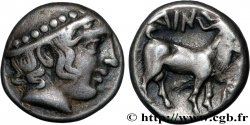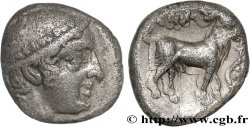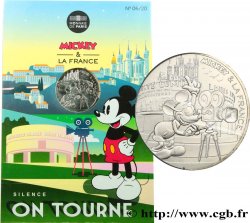v51_0049 - THRAKIEN - AINOS Diobole
MONNAIES 51 (2011)
Startpreis : 650.00 €
Schätzung : 950.00 €
Erzielter Preis : 840.00 €
Anzahl der Gebote : 3
Höchstgebot : 1 700.00 €
Startpreis : 650.00 €
Schätzung : 950.00 €
Erzielter Preis : 840.00 €
Anzahl der Gebote : 3
Höchstgebot : 1 700.00 €
Type : Diobole
Datum: c. 427/426 - 425/424 AC.
Name der Münzstätte / Stadt : Thrace, Aenos (Ainos)
Metall : Silber
Durchmesser : 12 mm
Stempelstellung : 3 h.
Gewicht : 1,37 g.
Seltenheitsgrad : R2
Kommentare zum Erhaltungszustand:
Exemplaire sur un flan large, bien centré des deux côtés. Très belle tête d’Hermès, bien venue à la frappe et de haut relief. Joli revers de style fin, bien détaillé. Belle collection de collection ancienne avec des reflets dorés
N° im Nachschlagewerk :
Pedigree :
Cet exemplaire provient du stock de Richelieu Numismatique, janvier 1997
Vorderseite
Titulatur der Vorderseite ANÉPIGRAPHE.
Beschreibung Vorderseite Tête d'Hermès à droite, coiffée du pétase sans bord, orné d'un grènetis, les cheveux flottant en mèches courtes.
Rückseite
Beschreibung Rückseite Bouc paissant à droite, la tête légèrement courbée ; devant un chardon.
Legende des Reverses : AINI
Übersetzung der Rückseite (d’Aenos).
Kommentare
Trace de cassure de coin perceptible au droit sur le pétase d’Hermès, le grènetis composé de douze perles. Légère trace de tréflage dans la légende. Le plant qu’ingurgite le bouc est finement détaillé. Notre exemplaire est très proche de ceux de la collection Pozzi (n° 1034 et 1035, pl. XXXIV). Semble de même coin que l’exemplaire du Danish National Museum (SNG. Cop. n° 402, pl. 8).
Trace of die breakage visible on the obverse of the Hermes petasus, the beading composed of twelve pearls. Slight trace of plaiting in the legend. The plant that the goat ingests is finely detailed. Our example is very close to those in the Pozzi collection (nos. 1034 and 1035, pl. XXXIV). Seems to be of the same die as the example in the Danish National Museum (SNG. Cop. no. 402, pl. 8)
Trace of die breakage visible on the obverse of the Hermes petasus, the beading composed of twelve pearls. Slight trace of plaiting in the legend. The plant that the goat ingests is finely detailed. Our example is very close to those in the Pozzi collection (nos. 1034 and 1035, pl. XXXIV). Seems to be of the same die as the example in the Danish National Museum (SNG. Cop. no. 402, pl. 8)








 Berichten über einen Fehler
Berichten über einen Fehler Die Seite drucken
Die Seite drucken Teilen meiner Auswahl
Teilen meiner Auswahl Stellen Sie eine Frage
Stellen Sie eine Frage Einlieferung/Verkauf
Einlieferung/Verkauf
 Details
Details















